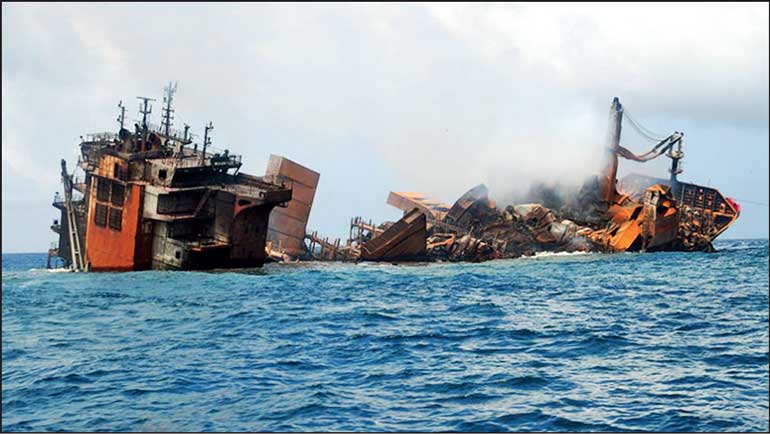Friday Mar 21, 2025
Friday Mar 21, 2025
Friday, 18 June 2021 00:11 - - {{hitsCtrl.values.hits}}

By Charumini de Silva
The Government yesterday revealed multiple ongoing efforts to assess as well as minimise the environmental impact from the burnt cargo vessel – the MV X-Press Pearl.
Describing the burnt out, sunk toxic-ship as Sri Lanka’s biggest marine pollution in the history, top officials from the Environment Ministry, Central Environmental Authority (CEA), Marine Environment Protection Authority (MEPA), National Aquatic Resources Research and Development Agency (NARA) and academia shed light on evidence-based primary investigations, which will later be submitted for litigation purposes via a virtual media briefing organised by the Government Information Department yesterday.
Environment Ministry Secretary Dr. Anil Jasinghe said carcasses that washed up soon after the fire had clear signs of burns from the intense heat of the ship, adding that preliminary reports also suggested chemical poisoning was behind more recent discoveries of dead turtles. He also said autopsies were being conducted to finalise the causes of death.
Wildlife officials said 48 dead turtles, eight dolphins, one whale as well as many small fish, had washed up on the western and southern beaches in recent weeks.
“To see these images of dead turtles and dolphins is very distressing for our people,” Dr. Jasinghe said.
He pointed out the calamity will further pose known and unknown threats to the entire ecosystem which will have long-term adverse impacts. He said experts are learning from similar incidents in Hong Kong and Norway to minimise the adverse impact for the country’s marine ecosystem.
Dr. Jasinghe also said that all the line ministries and institutions are working hard to collect data and analyse them with limited resources given the challenging situation with the pandemic restrictions.
CEA Chairman S. Amarasinghe said currently 1,000 tons of solid waste, mostly tiny plastic pellets, have been collected and are stored in 42 containers for any future investigation purposes.
“Around 1,000 Tri-Force personnel are working daily on collecting the piles of plastic pellets on the shore and lagoon areas. These have been put into gunny sacks and stored in 42 containers. There is more solid waste to be cleared, which is equivalent to another 10 containers,” he added.
Local firms that are registered under CEA and specialising in solid and chemical waste management have been identified to dispose of this massive pile of polythene pellets and other solid waste from the shipwreck in future.
“CEA will dispose of these large quantities of waste without harming the environment any further. The groundwork and resources are being processed,” Amarasinghe assured.
MEPA Chairperson Dharshani Lahandapura said the MV X-Press Pearl owner has appointed a caretaker firm to monitor the scene of incident. She said the wreck removal can only start once the South-West (SW) monsoon season ends.
She ruled out an oil spill, but said there is approximately 300 metric tons of bunker oil still remaining in the wrecked-ship as per the written primary confirmation received from the MV X-press Pearl-appointed rescue firm. Lahandapura said a natural resources damage assessment with all findings will be submitted within three months for litigation purposes.
Prof. Ruchira Kumaratunga, who established the country’s first university Oceanography Department at the University of Ruhuna, said it is extremely complicated to pinpoint the cause of the death of animals such as turtles, dolphins, fish and whales without proper autopsy and further investigation.
“The initial analysis suggests the death of most turtles were due to burn or chemical reactions with their shells damaged, but now we see their mouths wide open same with dolphins and fish which suggests breathing difficulties. These are initial observations. Over the weeks, the conditions of the carcasses have changed very rapidly, and we cannot exactly say the cause without a proper autopsy,” she said.
Prof. Kumaratunga also said some of the carcasses found on the beach were eaten by dogs and monitors, while the public too have tried to meddle with it and failed to inform the correct institution to collect the carcasses for investigation.
It was also revealed that autopsy results in fish and whales have found plastic pellets in the gut and it is not an easy task to continue further dissection and investigation.
“These are time consuming investigations and cannot be done overnight,” she pointed out. University of Sri Jayawardenapura Resource Economics Unit – Environmental Economics Prof. Prashanthi Gunawardena and University of Moratuwa Dean – Faculty of Graduate Studies Prof. Ajith de Alwis also spoke at the media briefing.
Discover Kapruka, the leading online shopping platform in Sri Lanka, where you can conveniently send Gifts and Flowers to your loved ones for any event including Valentine ’s Day. Explore a wide range of popular Shopping Categories on Kapruka, including Toys, Groceries, Electronics, Birthday Cakes, Fruits, Chocolates, Flower Bouquets, Clothing, Watches, Lingerie, Gift Sets and Jewellery. Also if you’re interested in selling with Kapruka, Partner Central by Kapruka is the best solution to start with. Moreover, through Kapruka Global Shop, you can also enjoy the convenience of purchasing products from renowned platforms like Amazon and eBay and have them delivered to Sri Lanka.
Discover Kapruka, the leading online shopping platform in Sri Lanka, where you can conveniently send Gifts and Flowers to your loved ones for any event including Valentine ’s Day. Explore a wide range of popular Shopping Categories on Kapruka, including Toys, Groceries, Electronics, Birthday Cakes, Fruits, Chocolates, Flower Bouquets, Clothing, Watches, Lingerie, Gift Sets and Jewellery. Also if you’re interested in selling with Kapruka, Partner Central by Kapruka is the best solution to start with. Moreover, through Kapruka Global Shop, you can also enjoy the convenience of purchasing products from renowned platforms like Amazon and eBay and have them delivered to Sri Lanka.